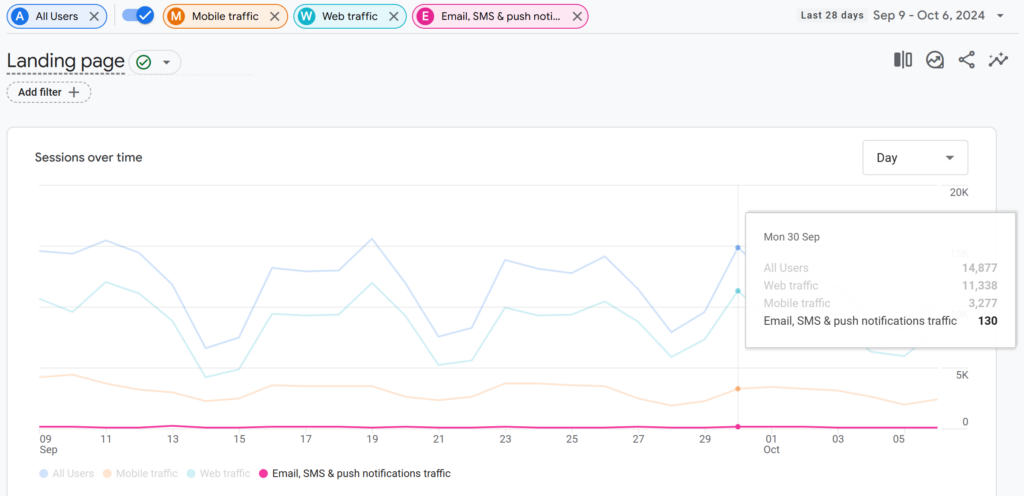Landing Page Traffic Comparison Analysis
Upon analyzing the landing page traffic from various sources—mobile traffic, web traffic (desktop), and traffic from email, SMS, and push notifications—we identified distinct patterns:
- Mobile Traffic: Shows a slight fluctuation in user engagement, represented by a minor curve in the traffic trendline. Mobile sessions average 47 seconds, indicating fairly consistent, but slightly shorter engagement compared to other channels.
- Web Traffic: Primarily driven by desktop users, web traffic shows a more stable engagement pattern, averaging 53 seconds per session. This reflects higher engagement from users browsing via desktop, who typically spend more time exploring content.
- Email, SMS, & Push Notifications Traffic: This segment shows a straight line in the trend, suggesting consistent behavior across sessions. The average session duration aligns closely with the overall average, contributing to the 50-second session average across all channels.

Recommendations for Optimizing Landing Page Engagement
- Enhance Mobile User Experience:
- Observation: Mobile traffic has a slightly lower average session duration (47 seconds) compared to web traffic. This suggests that mobile users may not be engaging as deeply with the content.
- Recommendation: Optimize the landing page for mobile devices by simplifying navigation, reducing load times, and ensuring key information is easily accessible. Consider adding “sticky” CTAs to keep mobile users engaged longer.
- Leverage Personalization in Push Notifications and Emails:
- Observation: The traffic from email, SMS, and push notifications shows a straight line, which could indicate that users are quickly scanning the landing page and leaving without engaging much.
- Recommendation: Use more personalized and targeted content in emails, SMS, and push notifications. Test sending tailored messages based on user behavior, such as abandoned applications or program-specific interests, to encourage more time spent on the page.
- Improve Desktop Content Strategy:
- Observation: Web traffic shows higher session duration (53 seconds) compared to mobile. Desktop users appear to spend more time engaging with the page.
- Recommendation: Enhance the content on the desktop version by adding interactive elements, like videos or infographics, to maintain or increase engagement. Additionally, ensure that the content structure encourages deeper exploration of other sections of the site, such as program details, alumni stories, or application forms.
- A/B Test Engagement Strategies Across Channels:
- Observation: Different traffic sources yield varying session durations and engagement levels.
- Recommendation: Conduct A/B tests on different versions of the landing page. For mobile, test simplified layouts or one-click options to keep users engaged longer. For desktop, experiment with more in-depth content and clearer pathways to next steps (e.g., applying or learning more). For email, SMS, and push notifications, experiment with messaging and timing to see what prompts longer sessions or more meaningful interactions.
These recommendations aim to improve the user experience on the landing page across different traffic sources, encouraging more time spent and higher engagement overall.





